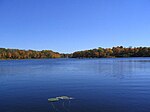Lake Langdon

Lake Langdon in Mound, Minnesota, has an area of 144 acres (0.6 km2). Minnehaha Creek Watershed District (MCWD) charts show its maximum depth of 38 feet (12 m), though it would be classified as a shallow lake with a mean depth of 8.3 feet (2.5 m). It is named for R. V. Langdon, the first township clerk. It is located west of Commerce Boulevard and south of Lynwood Boulevard. Boats on the lake cannot navigate to the nearby Lake Minnetonka, though it overflows into Lost Lake, part of the Big Lake, through Langdon Bay Creek. It also serves as an outlet for Saunders Lake, to its west. The lake has a watershed area to surface area ratio of 6.5:1, meaning that it drains an area about 6½ times its size. The lake (or bay as it is sometimes called) has an over abundance of phosphorus, that probably resulted from it being downstream from Mound's old sewer plant. The plant closed back in the late 1970s. Phosphorus is a catalyst that can contribute to excessive plant growth. Though the lake's MCWD Report Card shows a significant drop off of the phosphorus levels over the past 20 years, it is still a problem. A higher outflow from Langdon could lower the phosphorus level, but its water clarity remains poor, despite the fact that it was treated with Alum in 1998.
Excerpt from the Wikipedia article Lake Langdon (License: CC BY-SA 3.0, Authors, Images).Lake Langdon
Dakota Rail Regional Trail,
Geographical coordinates (GPS) Address Nearby Places Show on map
Geographical coordinates (GPS)
| Latitude | Longitude |
|---|---|
| N 44.933333333333 ° | E -93.675277777778 ° |
Address
Dakota Rail Regional Trail
Dakota Rail Regional Trail
55364
Minnesota, United States
Open on Google Maps






